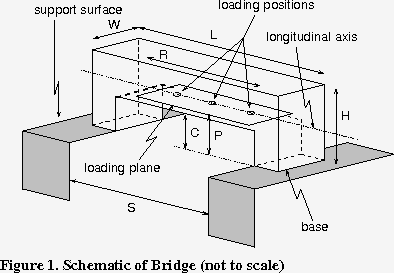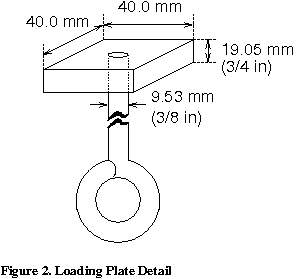
2010 International Bridge Building Contest Rules
These rules have been developed by the International Bridge Building
Committee for the Thirty Third International Bridge Building
Contest to be held on Saturday, May 1 in
Philadelphia, Pennsylvania, USA. If you have a question that is not answered by our
FAQ, please direct it to Robert Malkovsky, by e-mail at
rmalkovs@rtmsd.org.
In order to receive official wood and participate in this contest,
a High School student must have placed first or second in a Regional
Contest and be reported, by the Regional Coordinator, to Robert Malkovsky
by phone: (610) 627-6381, fax: (610) 891-0898, or e-mail: rmalkovs@rtmsd.org. Students may
participate in person, by proxy or by mail entry.
The object of this contest is to see who can design, construct and test
the most efficient bridge within the specifications.
Model bridges are intended to be simplified versions of real-world bridges,
which are designed to accept a load in any position and permit the load to
travel across the entire bridge.
1. Materials
-
The bridge must be constructed only from the official
3/32-inch square cross-section basswood included in the kit
and any commonly available adhesive.
-
The official basswood may be notched, cut, sanded or laminated in any
manner but must still be identifiable as the original official basswood.
-
No other materials may be used. The bridge may not be stained, painted or
coated in any fashion with any foreign substance.
2. Construction

-
The bridge mass shall be no greater than 30.00 grams.
-
The bridge (see Figure 1) must span a gap (S) of 300. mm, be no
longer (L) than 400. mm, be no taller (H) than 180. mm
above the support surfaces, and have a maximum width (W) of
70. mm. It must have a horizontal loading plane that
is a maximum height (P) of 80. mm above the support surfaces.
-
The bridge structure may not project below the support surfaces.
A bridge that deflects or partially fails such that a
portion of the bridge projects below the support surfaces and engages
the vertical front surface of the supporting structure will be
disqualified.
-
The bridge must be constructed to provide a horizontal support surface for
the loading plate and rod at each of the three possible loading positions.
These three positions, at the mid-span of the bridge and 60. mm to
either side of the center, will be clearly and consecutively labeled
"1, 2, 3" from either end of the bridge by the
participant before submission to the judges (see 3b). The horizontal loading
plane must be a minimum length (R) of 160. mm and centered on
the mid-span of the bridge. The bridge structure must allow the loading rod
(see 3a) to be mounted from below.
-
The bridge must have a minimum clearance (C) of 60. mm in height
above the support surfaces. This clearance also extends 80. mm toward
either end of the bridge from the center point of the bridge. It coincides
with the horizontal loading plane, and lies directly beneath it. No part of
the bridge structure may be built around this clearance area, and a
60. mm high, by 160. mm wide block must pass cleanly
under the bridge.
3. Loading
-
The load will be applied by means of a 40. mm square plate that is
19.05 mm (3/4 inch) in thickness. A 9.53 mm (3/8 inch)
diameter loading rod is attached from below to the center of the plate
(see Figure 2). The plate will be horizontal, it will not pivot on the
loading rod, and the sides of the plate will be parallel to the longitudinal
axis of the bridge.
-
The three loading positions will be located on the horizontal loading plane. The
center loading position (numbered "2") will be located at the center
point of the bridge. The other two loading positions (numbered "1" and
"3") will be located 60. mm toward either end of the bridge from
the center.
-
On the day of the competition, the judges will randomly draw the number of
the loading position to be used; it will be the same for all bridges tested.
4. Testing

-
On the day of the contest, participants will center their bridge on the
loading surfaces. They will have previously located the loading plate and
3/8 inch eye bolt to the selected loading position. A mechanical
sighting device will mark the bottom of the loading block (or top of the
loading plane). This is defined as the "zero" reference (starting point) for
measuring bridge deflection. The minimum load of 2 kg is then applied to
the bridge (as described in 3a above).
-
The load will be applied by the participant regulating a flow of sand from
a reservoir tank by means of a "throttle device" -- a simple
forward/backward two-handled mechanical lever that regulates the flow of
sand into a loading bucket. participants will be permitted to direct this
flow with their free hand, but may not touch the sides, handle or bottom of
the bucket itself. This includes any part of the testing device. If failure
occurs (see 4c) the throttle must be closed immediately. An experienced
judge will be on the opposite two-handled throttle to ensure this closure.
An effort to impede this closure will result in disqualification. The
maximum load supported by any bridge will be 50 kg. Any amount over this
quantity, will not count in the calculation of the bridge's efficiency.
The testing device itself will have the equivalent of 52 kg of sand in the
reservoir.
-
Bridge failure is defined as the inability of the bridge to carry additional
load, or a load deflection of 15 mm, whichever occurs first.
-
The bridge with the highest structural efficiency, E, will be
declared the winner.
E = Load supported in grams (50,000g maximum) / Mass of bridge in grams
5. Qualification
-
All construction and material requirements will be checked prior to testing
by the judges. Bridges that fail to meet these specifications at the
conclusion of the allowable time for checking will be disqualified. Bridges
disqualified prior to the start of the contest may be tested as exhibition
bridges at the discretion of the builder and the contest directors.
-
If, during testing, a condition becomes apparent (i.e., use of ineligible
materials, inability to support the loading plate, bridge optimized for a
single loading point, etc.) which is a violation of the rules or prevents
testing as described above in Section 4, that bridge
shall be disqualified. If the disqualified bridge can accommodate loading,
it may still be tested as an exhibition bridge as stated above.
-
Decisions of the judges are final; these rules may be revised as
experience shows the need.
(Please check our web site, http://www.iit.edu/~hsbridge, after
January 15, 2010, to learn whether any changes have been made.)
Last update: February 1, 2010
[ Bridge Contest Home ] [ International Contest ] [ Chicago Regional Contest ]
[ Region Locator ] [ Official Documentation ] [ Other Bridge Links ]
For further information, contact: Prof. Carlo Segre -
segre@iit.edu,
Illinois Institute of Technology
© International Bridge Building Committee, 2024



